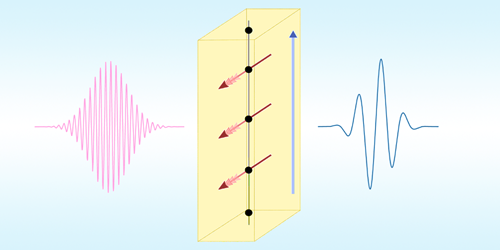How Demagnetization Drives Terahertz Emissions
In 1996, physicists made the surprising observation that a thin film of ferromagnetic nickel loses its magnetization when irradiated by ultrafast laser pulses. Further work hinted that coupled spin and charge currents are generated during this demagnetization and that the process emits detectable terahertz radiation. Jalil Varela-Manjarres and his colleagues at the University of Delaware now tie all these results together with a model that explains the details of the terahertz emission [1]. Their result could be applied to terahertz-radiation technologies and spintronic devices.
When a femtosecond laser pulse hits a ferromagnetic thin film, the loss of magnetism occurs because the laser’s electric field disrupts the electrons’ spin alignment. This process is thought to generate a spin current coupled to the electric field. If the ferromagnetic film is in contact with a nonmagnetic metal, the spin current should induce a perpendicular charge current in the nonmagnetic layer. This charge current was thought to generate the terahertz radiation seen in experiments, but the details of the mechanism have been a mystery.
Varela-Manjarres and his colleagues analyzed previously published experimental data using a version of quantum transport theory that they adapted for the purpose. They calculated the charge and spin currents that would flow in response to the electric field of an ultrafast laser pulse, and they computed the electromagnetic radiation that those currents would generate.
The researchers found that the terahertz radiation is generated not only by a charge current induced within the nonmagnetic layer but also by an additional charge current excited in the ferromagnetic layer itself by the demagnetization process. They say that an experiment involving a ferromagnetic film sandwiched between two nonmagnetic layers could provide “smoking gun” evidence that would confirm their model.
–Rachel Berkowitz
Rachel Berkowitz is a Corresponding Editor for Physics Magazine based in Vancouver, Canada.
References
- J. Varela-Manjarres et al., “Charge and spin current pumping by ultrafast demagnetization dynamics,” Phys. Rev. B 110, L060410 (2024).




